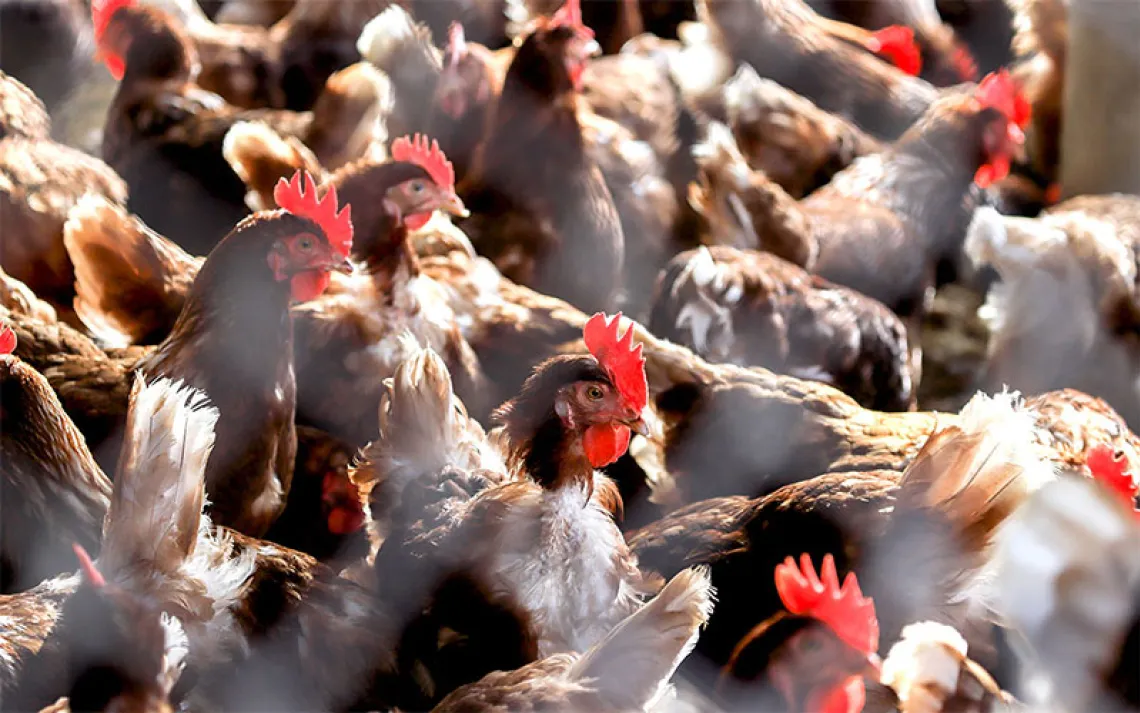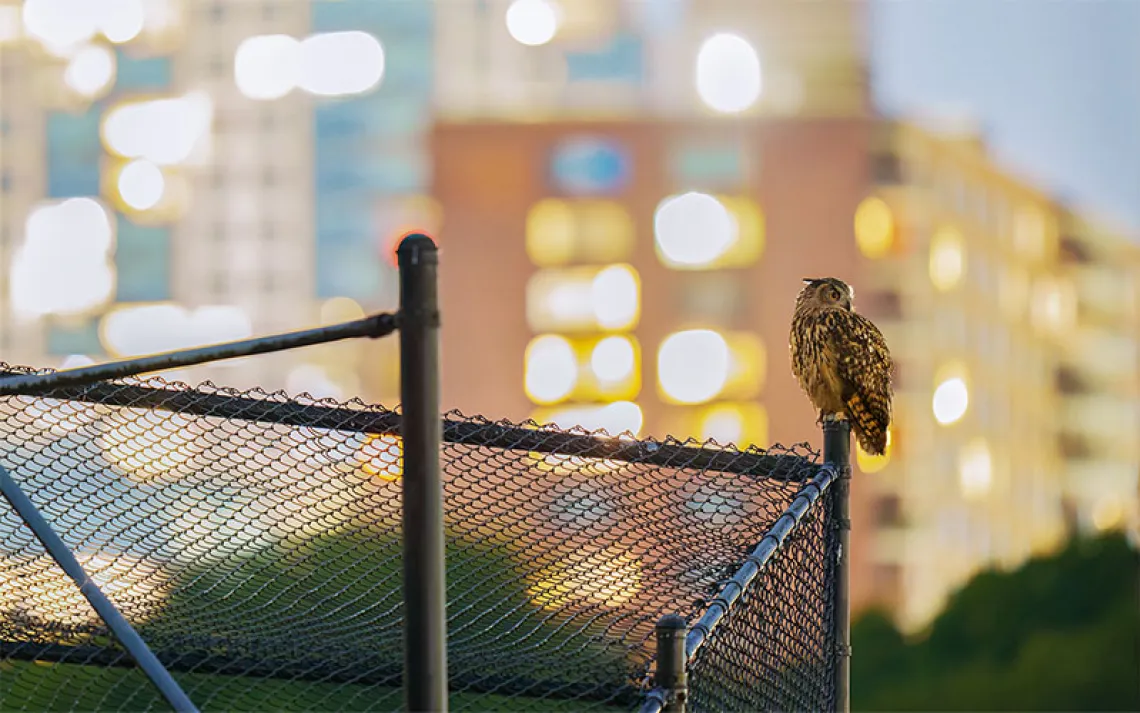California's Changing Climate Is Already Impacting Its Cavity-Nesting Songbirds
New research highlights how birds struggle to adapt in a changing world

A male tree swallow shows off his dazzling iridescence at UC Davis Putah Creek picnic grounds. | Photo by Zane Pickus/UC Davis
Agriculture and climate change are two of the most significant stressors for birds worldwide. Both are happening in California's Central Valley, and they’re already having some serious effects on local songbirds. While some species are adapting to their changing habitats, most birds are having a hard time reproducing. These are the conclusions of a new study published in the journal Biological Conservation in February.
"The birds that we're looking at in this study are as resilient as most in North America. They're widespread, and they're not expected to be particularly fragile with respect to any sort of changes," says Melanie Truan, a research ecologist at the UC Davis Museum of Wildlife and Fish Biology and one of the lead authors of the study. "And yet, we're still seeing changes. So, I think that that's really a clarion call for other species that are more fragile, that do have narrower distributions that could be impacted."
Many birds breed by making nests inside the cavities of trees, but over the past one hundred years, California's Central Valley has lost more than 90 percent of its riparian forest cover to agricultural expansion. It's also getting hotter: Research into California's changing climate suggests the state will experience a 5.4°F increase in temperature in the next 80 years. Studies also show it'll probably rain more between February and April and less between October and January, disrupting the mild California spring that is usually perfect for breeding birds.
This sort of "whiplash" is something we're already experiencing, according to Jason Riggio, a researcher in the Karp Lab in the Department of Wildlife, Fish and Conservation Biology at UC Davis and one of the authors of this study.
To understand how these changes could affect local birds, Truan and Riggio's team analyzed 11 years' worth of data collected by the Nestbox Highway project, an initiative by UC Davis that put up 200 nest boxes along Putah Creek.
"The nest is where the whole life cycle of the bird begins," says Truan, who started the Nestbox project in 2000. "A lot of impacts that affect birds can be readily seen … in the nest. It translates into survivorship and population dynamics over the long haul." Her team recorded over 2,300 nesting attempts by four local cavity-nesting songbird species, the western bluebirds, house wrens, tree swallows, and ash-throated flycatchers.
From this data, the researchers were able to confirm their initial hunch. Birds were hatching fewer eggs and smaller chicks when temperatures were higher and rainfall was excessive. It's a symptom that scientists call "lower reproductive fitness."
"What is really interesting here is that the climate was really having a strong effect," says Andrea Santangeli, a conservation scientist at the Institute for Mediterranean Studies, who was not involved in this study. "This was really consistent across the four species, which was quite striking."
There are various reasons the birds might be struggling to reproduce. For example, their breeding seasons aren't as mild as they used to be, and larger ecosystem changes, like prey and water availability, are altering what typically would have been ideal nesting conditions. Foraging gets harder for birds when it's hot, so parents struggle to feed their chicks, according to the researchers. At the same time, it takes a lot of energy for birds to adjust their body temperature and keep themselves cool—usually done by panting—so very hot birds may also burn more calories than they can eat.
The same happens the other way around. If it's raining very hard, it might be harder for these aerial insectivores to go out and forage. Birds that are wet tend to be cold, and if they can't regulate their temperature, they might end up perishing from hypothermia or spend more of their energy reserves trying to keep warm.
To survive, these species of cavity-nesting birds will probably have to change their breeding seasons or adapt to these intense changes during the breeding season, according to Riggio. "Although these anticipated effects are happening probably more quickly than physiological adaptation will occur," he says. "Or they're going to have to move, either more northward or up in elevation, but they won't be able to last on in Central Valley."
If changes in climate are already impacting California birds, Riggio notes, more sensitive species like Mediterranean ones along the Southern California coast—where warming is also expected to happen more quickly—are at an even greater risk.
One thing conservationists can already start thinking about, Riggio suggests, is restoring landscapes with a focus on providing more "thermal refugia" and space for birds to escape extreme weather. That could be as easy as increasing tree cover.
Likewise, rapid land use changes could affect cavity nesting birds' breeding habits. The human-made orchards that have replaced dense riparian forests have stolen perfect housing conditions for birds. These could easily serve as ecological traps, environments that animals mistakenly choose to inhabit despite inferior conditions. "The orchard is looking like a great place to reproduce, great, good habitat, we're going to go breed in those orchards," says Riggio. "But then orchards are monoculture; there's not a lot of diversity in there, and there's less prey availability."
In the case of ash-throated flycatchers, who also responded the best to changes in climate, the birds have decided to avoid orchards completely and have started to leave the area. Yet the study shows tree swallows and western bluebirds select orchards as often as, if not more than, their natural habitats. And when they do, they reproduce as well or better. "They seek out orchards," says Riggio. "And they're doing fairly well in orchards. There seems to be some adaption there."
The researchers still need to figure out whether this is an example of long-term resilience among these bird species or whether it's just working out for now. Truan and Riggio's team still needs more data on all of the areas of the valley that have been converted for other agricultural purposes. There needs to be more information on whether pesticides and other agricultural processes may influence whether birds can continue to live and reproduce as healthily as possible, now or in the future.
"[The authors] exclude this potential for an ecological trap for these species, of course, but we need to remember that biodiversity is much more than just a few species," says Santangeli, who has researched how birds respond to farmlands as ecological traps. If agriculture in the orchards were to become more intensive, with greater use of pesticides, for example, that might be problematic.
"I think it is a very rapidly changing world, so I think we should really be using the words 'for now,'" says Santangeli. Combining breeding performance measured in the nest with data from climate and land use is a helpful start to learn more about what the future has in store, according to Santangeli. "Up to a few years ago, we were really taking these two aspects rather separately, climate change and land use change," says Santangeli. "But of course, they interact."
 The Magazine of The Sierra Club
The Magazine of The Sierra Club



